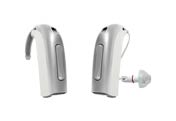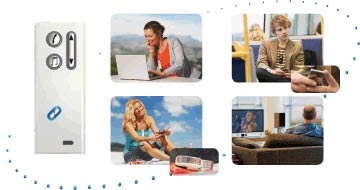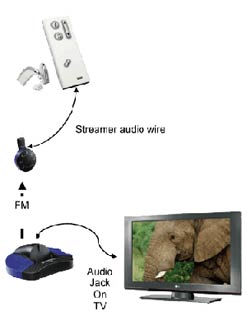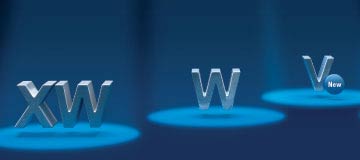Interview with Don Schum, Ph.D., Vice President of Audiology and Professional Relations, Oticon USA
Paul Dybala: Hi everybody! This is Dr. Paul Dybala with Audiology Online. Today, I'm here with Dr. Don Schum, who's going to talk with us about Oticon's wireless product, Epoq. Don, I appreciate you taking the time to meet with us.
Don Schum: Absolutely. No problem, Paul.
Dybala: If you would, tell us a little bit about your professional background and what you've been doing for Oticon lately.
Schum: I'm an audiologist by training. I've been with Oticon for 13 years. Previously, I worked at a couple of different university settings - at the Medical University of South Carolina for a few years and at the University of Iowa Medical School for five years.
In addition to being an audiologist, I'm a hearing aid guy by trade and by vocation. I've been fortunate to be able to work on the other side of the fence, within the hearing industry, for nearly 13 years.
Dybala: Great! What we're talking about today is Epoq. What I'd like to start off with, is talking about two basic things with Epoq - how the hearing aids wirelessly talk to each other, left to right, and how it wirelessly also connects to external devices.
Schum: Sure, Paul. We released Epoq in 2007 at the Audiology Now! Convention. It was, at the time, the first of a new series of products on a new digital platform that we had developed. The key to the digital platform is that it had a wireless transmitter and receiver built in to each and every hearing aid chip, which meant that it was essentially the smallest radio ever built. It was built onboard in the hearing instrument chip and could be built down to an ITC size.
We sought two basic purposes for having a wireless transmitter and receiver built into each hearing aid. One purpose was for the hearing aid to be able to accept signals from the outside world, and I'll talk about that in a little bit. But the most intriguing opportunity from an audiological perspective was for the two hearing aids to talk to each other.
This was a technology that was introduced by another manufacturer several years ago at a lower data exchange rate. Our engineers were able to increase that data exchange rate by over a hundredfold. And this faster data exchange rate from one side of the head to the other allowed us to achieve true binaural processing.
True binaural processing in hearing aids has been a goal and a dream of the hearing aid industry for decades, and Epoq was the hearing aid that made that dream come true.
Dybala: Can you explain the potential uses of sharing information from one side of the head to the other?
Schum: There's a variety of uses. At a very basic level, you can exchange control signals from one side of the head versus the other. So, if you turn up the volume controller switch, you can send that information to the other ear for the convenience of the patient.
That's what was originally introduced in the hearing aid market several years ago. As the data exchange rates gets higher, then you could start doing more complex processing. For example, you can synchronize the activity of environmentally adapted circuits like automatic directionality and noise reduction. And that just takes a higher data exchange rate and faster speeds in order to do that.
At the highest level of data exchange, you can do tasks. For example, one thing we're doing with Epoq is coordinating the compression response between the two hearing aids on either side of the head.
Dybala: So that affects localization?
Schum: Yes. There are important localization cues that are based on level differences on one side of the head versus the other.
We all learned in graduate school that localization in the horizontal dimension was based on interaural timing differences and importantly, interaural level differences. Unfortunately, with compression systems that are operating independently, when you have a weaker signal on one side of the head and a stronger signal on the other, they will respond differentially to those two signals. The problem with this is that you run the risk of destroying an important localization cue, interaural level differences. So, we use the binaural information exchange with our technology to maintain those naturally occurring level differences on one side of the head versus the other. Then, essentially there is an override or a modification of the compression response of the hearing aid. This override is designed to make sure that those interaural level differences are maintained to the degree that allows patients to have access to naturally occurring localization cues.
And that's only possible when you can stream data at a high speed from one side of the head versus the other.
Dybala: Last year you published an article (Schum & Hansen, 2007) on AudiologyOnline based on research you've done regarding spatial resolution. Is spatial ability improved in subjects using Epoq versus other digital devices? Can you discuss some of your data?
Schum: Yes, probably the most intriguing data is data based on the SSQ Questionnaire. The SSQ is a relatively new questionnaire that was developed by the late Stewart Gatehouse along with Bill Noble. They were interested in developing a questionnaire that related to some of the other aspects of performance with hearing aids that we don't normally take a look at.
One of the features that they were very interested in was spatial abilities. And so, we have been using that questionnaire quite heavily in our work with Epoq because it was specifically designed to match up to spatial abilities. And probably the most intriguing finding we've had so far was concerning something that Gatehouse and Noble determined, using the SSQ, regarding the typical benefit of going from one hearing aid to two hearing aids.
Everyone in audiology agrees that for most patients, two hearing aids are better than one. And so, based on the original SSQ data, we found what the magnitude of that change would be. We compared Epoq with the spatial sound feature (what we refer to as the "coordination and compression of spatial sound") to independently operating high-end instruments, which at the time of the study were our Syncro instruments. When we compared Syncro performance to Epoq performance on the SSQ, patients increased their ratings at a very similar magnitude of when you go from one hearing aid to two hearing aids.
And so, that just kind of put in perspective the benefit that seemed to be afforded by this spatial system - it had a similar effect on performance as going from one hearing aid to two hearing aids.
Dybala: In addition to your objective data, what are you hearing from people who are wearing these systems?

Schum: What is very interesting about the patients' reports that we get back is that they are talking about things in dimensions that we typically haven't heard before.
Of course, we study subjective reports as well as objective data whenever we release each new generation of hearing aids. And normally, wearers talk about noise being softer, noise not being as difficult to deal with, or improved sound quality, or things in those sorts of dimensions.
But when we had patients describe the effect of wearing Epoq, they were using spatial-like terms. For example, they were saying that they "felt that sounds were back where they belonged" or that "sounds seemed to be in the proper perspective". They were using terminology that we typically don't hear from advanced-technology hearing aids, which indicated to us that they really were perceiving something different about the listening experience with this system.
Dybala: And this is attributed to the coordination of the compression systems between the ears?
Schum: Yes. We also believe that it's related to an improved bandwidth in Epoq;it goes out to 10,000 Hz. Also, a lot of these patients are now being fit with open fittings. That wasn't possible before because of improvements in feedback cancellation. And we believe that those three things - coordination of the compression systems, open fitting, and increased bandwidth - work together to give a different sound quality to patients, more of a three-dimensional sound quality.
Dybala: You mentioned expanded bandwidth, and we're starting to see that in the industry. But typically, people are only testing out to 8000 Hz, or hopefully they're testing out to 8000 Hz. [laughs] How does Oticon recommend that you fit out past 8000Hz - is there additional testing that you need to do to fit this instrument?
Schum: No, not at this point in time. It would be a little bit irresponsible for us to start saying, "Now everybody needs to have ultra-high-frequency audiometers, out to 10,000 and 12,000 and 16,000 Hz."
Dybala: Sure.
Schum: Instead, we assume that the person's hearing is changing across frequency in a reasonably gradual way, and so that we don't expect big surprises once you get past 8 kHz. But, as we look forward, we would expect that bandwidth would improve throughout the industry. And so, this issue about testing beyond 8K will come up somewhere down the road. It's not an issue now, I don't believe, but it may be an issue a few years down the road, when bandwidth is improved and when there's even more of a demonstration of the benefits of improved bandwidth. I don't think anyone is at all unhappy with the fact that we're out to eight to 10 kHz now in a lot of products in the marketplace.
Dybala: Up until now we've been talking about Epoq's communication between the two hearing aids. Let's get into how Epoq communicates with external devices as well.
Schum: There is no doubt how widespread Bluetooth signals are in our modern world - not just with cell phones and their wireless headsets. Bluetooth is creeping into many other consumer electronic devices. Bluetooth is a terrible technology for hearing aids, because Bluetooth requires a large antenna, and also, most importantly, it draws battery life. It just kills batteries. It is a very power-hungry technology, and well beyond what a hearing aid can normally handle.
And so, the hearing aid industry has had to decide how to deal with Bluetooth in order to get Bluetooth signals into hearing aids. And there have been two basic approaches. One is the boot approach, where you would take a BTE hearing aid and put a Bluetooth boot on it so that the hearing aid, for a temporary amount of time, can accept Bluetooth signals into it. The reason you need a boot is because the antenna is relatively large and you can't build it into the hearing aid itself.
Because of the power requirements, the only boots that I've seen are on hearing aids with 675 batteries and maybe 13 batteries. But, it's such a power-hungry technology that it really draws heavily on the power source that normally would run a hearing aid.
The other option that we and some other companies have opted for is a gateway solution. And what we mean by a gateway solution is that there's a body-worn device that will accept the Bluetooth signal coming in, and then that body-worn device turns the Bluetooth signal into a different wireless signal that's transmitted to the hearing aids.
Dybala: Can you explain a bit about this other wireless signal?
Schum: Sure. We are using a variation of near-field magnetic induction, or NFMI, as the wireless technology built within an Epoq. And the reason we use NFMI is that its power requirements are drastically smaller than the power requirements of Bluetooth. And so, you can send a Bluetooth signal to this body-worn device that has a much larger battery in it to accept the Bluetooth signals. Then, it transforms that signal into an NFMI signal, and that goes up to the hearing aids.
And, like I said, that seems to be the route that other manufacturers are also going as they start looking at getting wireless into the hearing aids. That's because NFMI, as a transmitter and receiver, requires much, much smaller space and drastically reduced power requirements. The smaller space and reduced power requirements enable us to put it into small hearing aids, down to an ITC size or a mini-BTE size. It's just a better technology within hearing aids.
Since it's not directly mate-able with Bluetooth signals or FM signals or anything else in the environment, however, you need this gateway device. We call our gateway device the Streamer, as to refer to the idea of streaming information into the hearing aids.
Dybala: And I see this ties in to a new solution you have for television.
Schum: Yes. We see the gateway device as being important for both Bluetooth signals, but also for other signals in the environment. Most recently, we've paired up with the Sennheiser corporation, who has a very good FM solution for television viewing. And we are promoting a very easy to install in-home FM-based television solution that would then interface with our Streamer to get the television signals to the hearing aids. No matter how much we don't want to pay attention to it, people like to watch television.
Dybala: [laughs]
Schum: There are plenty of good things to watch on television. And our patients love to watch television, whether we notice that or not. And as an industry we haven't developed a really good solution for a lot of these patients.
Sometimes, the hearing aids alone work just fine. But a lot of patients who wear just their hearing aids have historically been somewhat frustrated by television viewing. By pairing up with Sennheiser, we've created a very elegant, easy-to-use, high quality solution for television viewing that can be used with any one of our Epoq products.

Dybala: Excellent! That brings up an interesting question that I was thinking of earlier. Have you found that there's a certain patient demographic that fits Epoq?
Schum: That's one of the target demographics of a product like this, but it goes well beyond that. We had an expert on ageing and technology come speak to us one day and basically, her message was if you build it to be easy to use and useful, they will come. This notion that this technology is only for that 58 year old businessman on the go, that's a stereotype image of who needs to have good phone access. There are a couple of very good Bluetooth home phone interfaces that we have promoted because they work well as a way of getting home phones into the hearing aid. And so, between the home phones and the television solution, we believe that this is a very broad based need that patients have and we believe Epoq is good solution for that.
Epoq goes against the notion that older individuals are not interested in using technology. They're very interested in using technology as long as it's very useful to them and very usable to them. That's why we've been so enthused about some of the solutions that we've come up. We believe that they meet both the usability and usefulness criteria that we set up for ourselves.
Dybala: Do you have any interesting stories about how patients have been using this technology?
Schum: Well, I'll give you a good example. My wife has an audiology private practice. She fit a young woman in our community with Epoq who had a bilateral hearing loss. We got into a conversation about how well this person was doing. And it turns out my wife ended up hiring the woman as her receptionist. And one of the concerns that this young woman had was that she would have problems on the phone because of her hearing loss.
Well, we got her a streamer for her Epoq, as well as a very good Bluetooth interface to the office phone. And now, she's worked out extremely effectively as a front office person to the point where she's in the process of getting her dispensing license and her audiometric assistance certificate so that she can be part of the care process. It's just a great success story of an Epoq wearer.
Dybala: What a great story! Don, before we close out the interview today, can you explain a bit about the different models in the Epoq line?
Schum: We have three models of Epoq - Epoq XW, Epoq W and Epoq V. Epoq V is the brand new bundle that was released at the AudiologyNow! Convention in Charlotte earlier this month. Epoq XW is the fully functional wireless version. It has the binaural communication between the two hearing aids that's used for full implementation of the compression coordination spatial sound system.
Epoq W is in the middle of the product line. It has the wireless synchronization and coordination between the ears so that the noise reduction system and the adapted directional system are coordinated between the ears. And, of course, the simple practicalities of changing switch on one side of the head to change the switch on the other virtually, things like that.
The new member of the Epoq family is Epoq V. And that has ear to ear communication only at the level of convenience, so that moving a control or switch on one side of the head moves it on the other side of the head in a virtual way. All of the Epoq products though have wireless connectivity to what we refer to as the "far world," meaning outside signals getting into the hearing aid.
So, the Epoq V is very much targeted to a much broader audience, especially those who are interested in a good television solution and a good telephone solution beyond having an excellent high-end product. So, all three Epoq models have wireless communication to the outside world. The difference in the three models is how sophisticated the communication from one side of the head to the other side of the head is.
Dybala: Well, Don, thank you so much for taking time to talk with us today and giving us an update on Epoq. For anyone who'd like more information about Oticon or Epoq, visit the Oticon website, www.oticonusa.com. You can also check out Oticon's web channel at AudiologyOnline, www.audiologyonline.com/channels/oticon.asp for the latest in news and product information from Oticon.
Schum: Thank you for your interest and thank you for your time, Paul.
References
Schum, D., Hansen, L. (2007, August 20). New Technology and Spatial Resolution. AudiologyOnline, Article 1854. Direct URL: www.audiologyonline.com/articles/article_detail.asp?article_id=1854
Retrieved May 6, 2008, from the Articles Archive on www.audiologyonline.com


